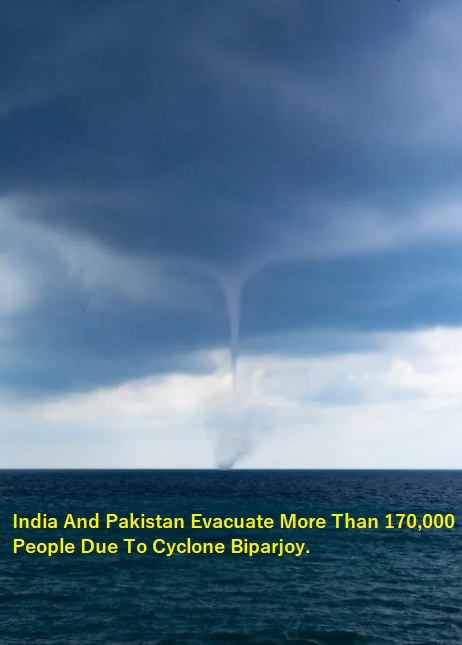Before Cyclone Biparjoy made landfall in the two countries, more than 170,000 people were relocated. Forecasters have warned that the storm could be the worst to hit the region in 25 years and that it poses a threat to nearby homes and crops. Parts of Pakistan’s Sindh province and India’s Gujarat state are expected to be hit by the cyclone.
Cyclone Biparjoy, which translates as a “disaster” in Bengali, is expected to make landfall on the Gujarati coast around Jakhau port and the Sindhi coast near Keti Bandar. Storm surges as high as 3-4m (10-13ft) along the coastline from Karachi to Gujarat, according to a warning from Pakistan’s disaster management organization. The cyclone’s intensity had decreased, but according to Alok Pandey, the man in charge of relief efforts in Gujarat, wind speeds at the time of impact were still anticipated to be at “very dangerous” levels of between 110-125 km/h (68-78mph).

Ships, helicopters, and planes from the Indian Coast Guard and Armed Forces have been kept ready for rescue and relief operations. Rushikesh Patel, the health minister for Gujarat, urged people not to travel. We want there to be no casualties, he stated. In India earlier this week, there were at least seven recorded fatalities due to torrential rains. According to the AFP news agency, the victims included a woman riding a motorbike who was struck by a falling tree and two toddlers who were crushed by a crumbling wall.
The storm is anticipated to hit Pakistan’s Sindh province’s coastline. Authorities have established 75 relief camps at schools and evacuated 81,000 residents from the southeast coast. Despite having a population of over 20 million, Ms. Rehman claimed that Karachi, the largest city in Pakistan, was not now in danger. High tides could flood low-lying coastal communities, meteorologists warned.

Since Wednesday, Mandvi and other coastal Gujarat locations have seen torrential rain and strong gusts. Videos that showed rain-soaked debris flying were circulated by local media sites. 94,000 people, according to Gujarat state officials, were evacuated from coastal locations.
Authorities said a number of train services in Gujarat have been halted as well as the closure of two of India’s main ports, Kandla and Mundra. Gujarat’s coastline has banned fishing, while Pakistan’s coastal region has also issued a stay-on-shore warning to fishermen. According to BBC Gujarati, the Gujarati government has also established control rooms to monitor the security of Asiatic lions in the Gir forest and coastal areas. The Asiatic lion’s sole natural habitat is the Gir forest.
In order to provide help, 12 state disaster relief teams and 18 national disaster relief teams have been stationed in Gujarat’s most important cities. Depending on how powerful the storm is, they will concentrate on making sure that key services are not damaged or are at least quickly restored. Biparjoy is predicted by the Indian Meteorological Department to “fall in intensity” as it advances inland.
In the Indian Ocean, cyclones—also known as news in the North Atlantic and typhoons in the North-West Pacific—are a frequent and dangerous occurrence. Due to recent increases in surface temperatures over the Arabian Sea brought on by climate change, nearby areas are now considerably more at risk of catastrophic storms.
The most recent powerful cyclone to hit the same area was Cyclone Tauktae in May 2021. It resulted in 174 deaths. The evacuation of Biparjoy brought back dreadful memories of another storm that struck the Gujarat coast 25 years ago, leaving a trail of devastation and death in its wake. Locals claim that the actual death toll was significantly greater than the official estimate of 4,000.
Abbas Yakub, a 40-year-old fisherman seeking refuge at a primary school in Mandvi, said, “We have experienced cyclones before, but this time it looks very bad.” At the makeshift shelter, he was one of 150 residents.
“Because of where our house is located, waves already touched it early yesterday morning. We’re not sure where we’ll be going back to,” he remarked.
The youngest occupant at another shelter, a school protecting some 300 people, was Ishaad, who was only three days old. Shehnaz, his mother, expressed concern about their future.
How will I manage with my infant if something occurs at my house? To what will I return?

